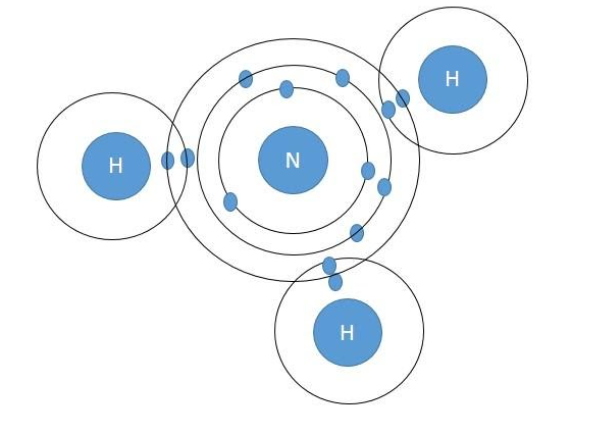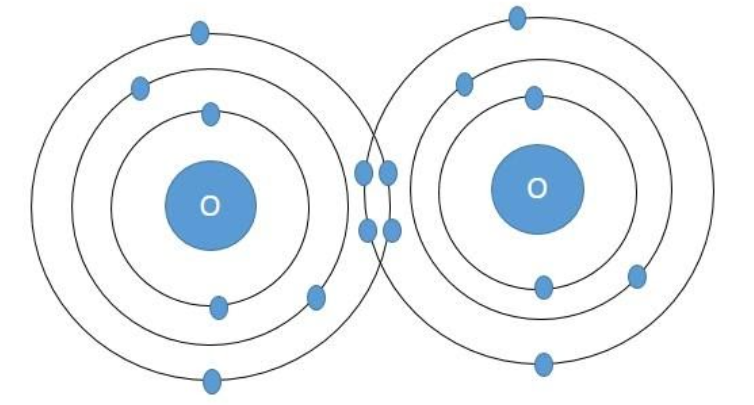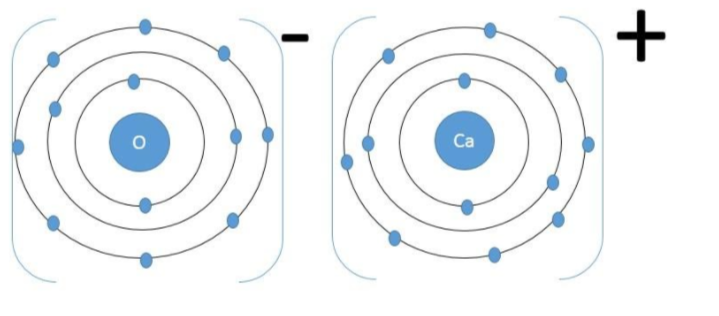
Answer
410.1k+ views
Hint: The arrangement of all the electrons in an atom of an element or the molecule of a compound in all its orbits is known as the orbit structure of the element or the compound.
Complete answer:
Oxygen molecule – In the atom of oxygen, there are total eight electrons arranged in the electronic configuration:$\text{1}{{\text{s}}^{\text{2}}}\text{2}{{\text{s}}^{\text{2}}}\text{2}{{\text{p}}^{\text{4}}}$. Accordingly, there are a total of six electrons in the valence shell of the oxygen atom and it is short of two electrons to attain the octet confirmation. So the oxygen atom shares two electrons with another oxygen atom to form the oxygen molecule according to the following diagram.

Ammonia – In the ammonia molecule, there is one nitrogen atom and three hydrogen atoms. The electronic configuration of nitrogen is $\text{1}{{\text{s}}^{\text{2}}}\text{2}{{\text{s}}^{\text{2}}}\text{2}{{\text{p}}^{3}}$and that for hydrogen is$\text{1}{{\text{s}}^{\text{1}}}$. Hence hydrogen is one electron short of duplet and nitrogen is three electrons short of an octet. So the nitrogen forms three covalent bonds with hydrogen atoms to form ammonia.

Calcium Oxide – The electronic configuration of calcium is$\text{1}{{\text{s}}^{\text{2}}}\text{2}{{\text{s}}^{\text{2}}}\text{2}{{\text{p}}^{6}}\text{3}{{\text{s}}^{\text{2}}}\text{3}{{\text{p}}^{\text{6}}}\text{4}{{\text{s}}^{\text{2}}}$. So the calcium atom donates two of its valence shell electrons to form the calcium dipositive cation while the oxygen atom takes up those electrons to form the oxide anion and together they form the calcium oxide ionic solid.

Note:
The atoms gain or lose electrons to attain a stable electronic confirmation. But when the number of electrons required to attain the octet configuration is too large, then the atoms prefer to share the electrons and form covalent bonds instead of gaining or losing electrons.
Complete answer:
Oxygen molecule – In the atom of oxygen, there are total eight electrons arranged in the electronic configuration:$\text{1}{{\text{s}}^{\text{2}}}\text{2}{{\text{s}}^{\text{2}}}\text{2}{{\text{p}}^{\text{4}}}$. Accordingly, there are a total of six electrons in the valence shell of the oxygen atom and it is short of two electrons to attain the octet confirmation. So the oxygen atom shares two electrons with another oxygen atom to form the oxygen molecule according to the following diagram.

Ammonia – In the ammonia molecule, there is one nitrogen atom and three hydrogen atoms. The electronic configuration of nitrogen is $\text{1}{{\text{s}}^{\text{2}}}\text{2}{{\text{s}}^{\text{2}}}\text{2}{{\text{p}}^{3}}$and that for hydrogen is$\text{1}{{\text{s}}^{\text{1}}}$. Hence hydrogen is one electron short of duplet and nitrogen is three electrons short of an octet. So the nitrogen forms three covalent bonds with hydrogen atoms to form ammonia.

Calcium Oxide – The electronic configuration of calcium is$\text{1}{{\text{s}}^{\text{2}}}\text{2}{{\text{s}}^{\text{2}}}\text{2}{{\text{p}}^{6}}\text{3}{{\text{s}}^{\text{2}}}\text{3}{{\text{p}}^{\text{6}}}\text{4}{{\text{s}}^{\text{2}}}$. So the calcium atom donates two of its valence shell electrons to form the calcium dipositive cation while the oxygen atom takes up those electrons to form the oxide anion and together they form the calcium oxide ionic solid.

Note:
The atoms gain or lose electrons to attain a stable electronic confirmation. But when the number of electrons required to attain the octet configuration is too large, then the atoms prefer to share the electrons and form covalent bonds instead of gaining or losing electrons.
Recently Updated Pages
How many sigma and pi bonds are present in HCequiv class 11 chemistry CBSE

Mark and label the given geoinformation on the outline class 11 social science CBSE

When people say No pun intended what does that mea class 8 english CBSE

Name the states which share their boundary with Indias class 9 social science CBSE

Give an account of the Northern Plains of India class 9 social science CBSE

Change the following sentences into negative and interrogative class 10 english CBSE

Trending doubts
Fill the blanks with the suitable prepositions 1 The class 9 english CBSE

Difference between Prokaryotic cell and Eukaryotic class 11 biology CBSE

Differentiate between homogeneous and heterogeneous class 12 chemistry CBSE

Give 10 examples for herbs , shrubs , climbers , creepers

Change the following sentences into negative and interrogative class 10 english CBSE

Difference Between Plant Cell and Animal Cell

Write a letter to the principal requesting him to grant class 10 english CBSE

The Equation xxx + 2 is Satisfied when x is Equal to Class 10 Maths

Who is known as the Father of Yoga class 8 biology CBSE



